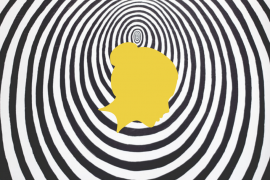MYRIAD COMIC SERIES, TELEVISION SHOWS, MOVIES, ACTION FIGURES, and other various capitalistic ventures have grossed billions on the back of the Caped Crusader. It seems nearly impossible to step into the public square without coming across children and adults alike adorned with some form of the Bat. (But on those instances in which the Winged Avenger is unseen, we must not forget he often adorns unmentionables.) In the midst of this Batman craze that has flooded the minds of so many for the last eight decades, there is one character from Gotham who has sacrificed more than even Batman, without proper recognition: one who has given so much as to be little more than a facade; one who has been pushed beyond the limits of most men; one who has trudged through the darkest dens of thieves, killers, and his own soul, yet came out renewed on the other side; the true hero under the mask, Bruce Wayne. I am persuaded that it is Christopher Nolan’s rendition of The Batman that most authentically exhibits Bruce Wayne’s true position in Gotham’s saga via the salvific-triune—repentance, redemption, and resurrection—in his Dark Knight Trilogy.
As fanboys read, discuss, and trade their favorite comics, the man behind the mask often slips their minds. Batman dons the title, the World’s Greatest Detective; yet, ironically enough, this moniker is only bestowed on him because he is exalted above the justice system. Why? How does this balance work? Because, as a symbol, Batman is beyond corruption, fear, limitations, and, quite honestly, the law. However, though the title would seem to suggest otherwise, in Christopher Nolan’s Dark Knight Trilogy it is Batman’s humanity that rises to the forefront: his physical and mental weaknesses, his fears, his regrets, and even his corruptibility are the story arc’s impetus. In Nolan’s version of the Dark Knight, the viewer is privy to the real complexities that give birth to, arise within, and befall the man behind the mask, Bruce Wayne.
Nolan’s origin account, Batman Begins, highlights the psychological issues that guide Bruce Wayne’s transformation from privileged boy to vengeful teen to misguided seeker to resolute vigilante. What should be noticed within this transformation is Bruce Wayne. He is the one struggling. He is the one who must face down his own privileges and demons. He is the one who must make the decision to, first, sacrifice his status in order to taste the ugly side of life, and second, return from the dead so that he may sacrifice his family-name to hide his high-minded vigilantism. This first film seems to have its own repentance, redemption, and resurrection. Yet, in this story, Nolan introduces the element that will, by the end of the trilogy, require true, full repentance, redemption, and resurrection from Bruce Wayne—Batman’s pragmatic twist on justice. This twist is highlighted in Batman’s “internal conflicts between the good he aspires to restore and the means he deploys.”1 Namely, in Batman Begins, when Batman chooses not to save Ra’s Al Ghul.
Continuing on to The Dark Knight. The Dark Knight is more a noir style tragedy that brings the World’s Greatest Detective into a modern, realistic world—a world in which a darker hero seems to best suit the dark reality surrounding him. In The Dark Knight, the viewer watches as Batman takes on his archenemy, the Joker, in a tale that pushes the Bat (and almost every other hero of the story) to trample on the moral line of truth that should undergird a just system. The longer he chases the Joker, the further down the rabbit hole of questionable actions he must travel to catch this prodigious villain.
In the closing of The Dark Knight, the viewer watches as Gotham’s so-called White Knight (Harvey Dent), who has just finished a vengeful killing spree, holds a child hostage. To rescue the kid, Batman must kill Dent, though he just saved the Joker. Standing over Dent’s body, Batman tells Gordon that he will take the blame for Dent’s homicidal vengeance, thus founding justice on the back of a lie, in a murderer’s honor. Nevertheless, it is justifiable because beating The Joker is more important than truth.
Batman has chosen to do whatever is necessary to bring about what he thinks is justice, just like Ra’s Al Ghul. In the world he is creating, there is no source of truth or definer of good, save himself. This will only lead to delusion and destruction—The Dark Knight Rises sets a good example of this.
In The Dark Knight Rises, Nolan introduces a character that highlights the Caped Crusader’s failures and injustices, John Blake. It seems to me that Nolan means this character to embody the opinion of the righteous, for he is the only one that never compromises. It is Blake that draws the viewer to pay attention to a certain aspect of Nolan’s trilogy that has been there along, but unnoticed: Ra’s Al Ghul has been defeated; The Joker has been arrested; yet, justice has not prevailed, nor has the city been redeemed from the darkness that caused the Bat to rise from the cave in the first place. Blake causes us to see that the first two films do not entail Batman’s rise to power, but his rise to compromise. A fact that the Bat knows; therefore, as Rises opens, we find that he has withdrawn to reclusion, wallowing in despair, regret, and defeat.
But Blake, by appealing to Wayne’s heart, leads Batman back into the public arena. And here, at last, Batman will be brought to repentance by Bane. Bane plans to resurrect Ra’s Al Ghul’s plan of destroying Gotham. A central part of this plan is to completely break Batman by undoing his entire legacy, by bringing every lie but one, Batman’s real identity, to the forefront for public judgment. With this threat, the Winged Avenger can no longer hide in the shadows. In this conflict, the spiritually broken Bat is finally crushed physically—the push he needed.
Deep in the appropriately named Lazarus Pit, Gotham’s Goliath is brought low. He can longer use his physicality to flee his pain. In this cave, where his greatest sins are exposed to the world, he is overwhelmed with sorrow, a sorrow that leads to repentance, but not Batman’s repentance. The Bat that had hidden the man was broken. Now the man must face up to all the weight that he shortsightedly hung on the symbol, the Bat. Repentance leads to renewed vigor. It is Wayne that struggles through the physical and spiritual brokenness. It is Wayne that is redeemed from the shadow of the Bat. And, finally, it is Wayne who resurrects from the Pit.
By the end of Rises, the Dark One has risen into the light of a nuclear flash and been consumed. The one lie that remains is the people never know who Batman was. And that is the real price that Bruce Wayne pays. In the end, it is the people of Gotham who believe the Dark Knight to be their savior, but those closest to the whole truth know that Bruce Wayne is the one who actually sacrificed everything and is reborn to a new life.
Once Nolan’s Dark Knight Trilogy comes to a close, we can finally look back and see the truth that was displayed all along. It is not Batman that is broken and repents. It is not Batman that is redeemed in the prison nor resurrected from the Pit. It is not the Bat that sacrifices himself in every way to save Gotham. It is Bruce Wayne. It is Bruce Wayne that the viewer sees become Gotham’s true White Knight.
In the end, he does, in fact, get back up.
- Thomas S. Hibbs, Shows About Nothing: Nihilism in Popular Culture (Waco: Baylor University Press, 2012), 183.
Like what you’re reading?
Get new stories or poetry sent to your inbox. Drop your email below to start >>>
OR grab a print issue
Stories, poems and essays in a beautifully designed magazine you can hold in your hands.
GO TO ISSUESNEW book release
I’ll Tell You a Love Story by Couri Johnson. Order the book of which Tim Jeffries said, “Surprising in their originality, filled with broken wisdom, and with a refreshing use of language and imagery, these are stories to savour and mull over one at a time but which add up to a satisfying whole.”
GET THE BOOK



